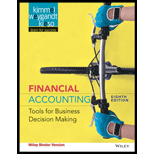
Financial Accounting 8th Edition
8th Edition
ISBN: 9781119210818
Author: Kimmel, Weygandt, Kieso
Publisher: WILEY
expand_more
expand_more
format_list_bulleted
Question
Chapter 12, Problem 12.1EYCT
(a)
To determine
Statement of
Statement of cash flow is a financial statement that shows the cash and cash equivalents of a company for a particular period of time. It shows the net changes in cash, by reporting the sources and uses of cash as a result of operating, investing, and financing activities of a company.
Cash flows from operating activities: These refer to the cash received or cash paid in day-to-day operating activities of a company.
Indirect method: Under this method, the following amounts are to be adjusted from the Net Income to calculate the net cash provided from operating activities.
- Deduct increase in current assets.
- Deduct decrease in current liabilities.
- Add decrease in current assets.
- Add the increase in current liability.
- Add
depreciation expense and amortization expense. - Add loss on sale of plant assets.
- Less gain on sale of plant assets.
To determine: the amount of net cash provided by operating activities of Incorporation A.
(b)
To determine
the amount of amount of increase or decrease in cash and cash equivalents of Incorporation A.
(c)
To determine
the method of computing net cash provided by operating activities of Incorporation A.
(d)
To determine
the amount of increase or decrease in Accounts receivable , inventory and accounts payable.
(e)
To determine
the amount of net cash used by investing activities of Incorporation A.
(f)
To determine
the amount of interest paid and amount of income taxes paid of Incorporation A.
Expert Solution & Answer
Want to see the full answer?
Check out a sample textbook solution
Students have asked these similar questions
Hii teacher please provide for General accounting question answer do fast
Accounting ?
Get correct solution this financial accounting question
Chapter 12 Solutions
Financial Accounting 8th Edition
Ch. 12 - Prob. 1QCh. 12 - Prob. 2QCh. 12 - Prob. 3QCh. 12 - Prob. 4QCh. 12 - Prob. 5QCh. 12 - Prob. 6QCh. 12 - Why is it necessary to use comparative balance...Ch. 12 - Prob. 8QCh. 12 - Prob. 9QCh. 12 - Prob. 10Q
Ch. 12 - Prob. 11QCh. 12 - Prob. 12QCh. 12 - Prob. 13QCh. 12 - Prob. 14QCh. 12 - Prob. 15QCh. 12 - Prob. 16QCh. 12 - Prob. 17QCh. 12 - Prob. 18QCh. 12 - Prob. 19QCh. 12 - Prob. 20QCh. 12 - Prob. 21QCh. 12 - Prob. 22QCh. 12 - Prob. 12.1BECh. 12 - Prob. 12.2BECh. 12 - Prob. 12.3BECh. 12 - Prob. 12.4BECh. 12 - Prob. 12.5BECh. 12 - Prob. 12.7BECh. 12 - Prob. 12.8BECh. 12 - Prob. 12.9BECh. 12 - Prob. 12.10BECh. 12 - Prob. 12.11BECh. 12 - The management of Uhuru Inc. is trying to decide...Ch. 12 - Prob. 12.13BECh. 12 - Prob. 12.14BECh. 12 - Prob. 12.15BECh. 12 - Prob. 12.1DIECh. 12 - Prob. 12.2ADIECh. 12 - Prob. 12.2BDIECh. 12 - Prob. 12.3DIECh. 12 - Prob. 12.1ECh. 12 - Prob. 12.2ECh. 12 - Prob. 12.3ECh. 12 - Prob. 12.4ECh. 12 - Prob. 12.5ECh. 12 - Prob. 12.6ECh. 12 - Prob. 12.7ECh. 12 - Prob. 12.8ECh. 12 - Prob. 12.9ECh. 12 - Prob. 12.10ECh. 12 - Prob. 12.11ECh. 12 - Prob. 12.12ECh. 12 - Prob. 12.13ECh. 12 - Prob. 12.14ECh. 12 - Prob. 12.15ECh. 12 - Prob. 12.1APCh. 12 - Prob. 12.2APCh. 12 - Prob. 12.3APCh. 12 - Prob. 12.4APCh. 12 - Prob. 12.5APCh. 12 - Prob. 12.6APCh. 12 - Prob. 12.7APCh. 12 - Prob. 12.8APCh. 12 - Prob. 12.9APCh. 12 - Prob. 12.10APCh. 12 - Prob. 12.11APCh. 12 - Prob. 12.12APCh. 12 - Prob. 12.1EYCTCh. 12 - Prob. 12.2EYCTCh. 12 - Prob. 12.3EYCTCh. 12 - Prob. 12.7EYCTCh. 12 - Prob. 12.8EYCTCh. 12 - Prob. 12.9EYCTCh. 12 - Prob. 12.1IFRSCh. 12 - Prob. 12.2IFRSCh. 12 - Prob. 12.3IFRS
Knowledge Booster
Similar questions
- What is the dollar value of the ending inventory under variable costing? Of general accounting question please solve and show explanationarrow_forwardOn January 1, 2025, Willow Tech Inc. reported a Salaries Payable balance of $39,000. Salaries Expense for 2025 totaled $512,000. The ending balance of Salaries Payable on December 31, 2025, was $46,000. What is the amount of cash paid for salaries in 2025?arrow_forwardCan you please solve this general accounting issue?arrow_forward
arrow_back_ios
SEE MORE QUESTIONS
arrow_forward_ios
Recommended textbooks for you
 Financial Accounting: The Impact on Decision Make...AccountingISBN:9781305654174Author:Gary A. Porter, Curtis L. NortonPublisher:Cengage LearningPrinciples of Accounting Volume 1AccountingISBN:9781947172685Author:OpenStaxPublisher:OpenStax College
Financial Accounting: The Impact on Decision Make...AccountingISBN:9781305654174Author:Gary A. Porter, Curtis L. NortonPublisher:Cengage LearningPrinciples of Accounting Volume 1AccountingISBN:9781947172685Author:OpenStaxPublisher:OpenStax College College Accounting (Book Only): A Career ApproachAccountingISBN:9781337280570Author:Scott, Cathy J.Publisher:South-Western College Pub
College Accounting (Book Only): A Career ApproachAccountingISBN:9781337280570Author:Scott, Cathy J.Publisher:South-Western College Pub Financial AccountingAccountingISBN:9781305088436Author:Carl Warren, Jim Reeve, Jonathan DuchacPublisher:Cengage Learning
Financial AccountingAccountingISBN:9781305088436Author:Carl Warren, Jim Reeve, Jonathan DuchacPublisher:Cengage Learning

Financial Accounting: The Impact on Decision Make...
Accounting
ISBN:9781305654174
Author:Gary A. Porter, Curtis L. Norton
Publisher:Cengage Learning


Principles of Accounting Volume 1
Accounting
ISBN:9781947172685
Author:OpenStax
Publisher:OpenStax College

College Accounting (Book Only): A Career Approach
Accounting
ISBN:9781337280570
Author:Scott, Cathy J.
Publisher:South-Western College Pub

Financial Accounting
Accounting
ISBN:9781305088436
Author:Carl Warren, Jim Reeve, Jonathan Duchac
Publisher:Cengage Learning